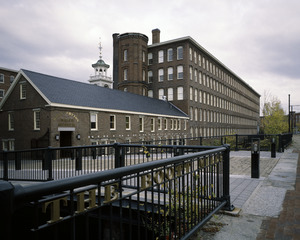Boott Mills facts for kids
The Boott Mills are a famous group of old cotton mills located in Lowell, Massachusetts. These mills were built in 1835 next to a special system of canals. Lowell was a very important town for making cotton products. The mills were named after Kirk Boott, who helped manage the canals in Lowell.
Today, the Boott Mills complex is one of the best examples of textile mills built before the American Civil War. Part of the original mill, called Mill No. 6, is now managed by the Lowell National Historical Park. It is home to the Boott Cotton Mills Museum and the Tsongas Industrial History Center, which offers educational programs for students.
Contents
Where are the Boott Mills?
Lowell is about 40 kilometers (25 miles) northwest of Boston. It is located on the Merrimack River. This spot was chosen because the Merrimack River had strong water power. There was also an existing canal, the Pawtucket Canal, which connected the Merrimack with the Concord River.
At Lowell, the Merrimack River drops about 9 meters (30 feet) over 2 kilometers (1.2 miles). This drop was perfect for creating a lot of power, about 7,460 kilowatts (10,000 horsepower). Water was moved through canals and locks for boats. The extra water could then be used to power large waterwheels for the mills.
History of the Boott Mills
Kirk Boott worked for the company that built the Merrimack Canal. This canal was the first "power canal" in Lowell. It was already helping to run other mills. Boott built his own mills in 1835. He used a special way of hiring workers called the Waltham-Lowell system.
At first, the mills ran only on water power. The original complex had four brick buildings with sloped roofs. Over time, more floors were added, giving them flat roofs. The buildings were connected by stair towers and clock towers. Other buildings were also added to the complex. Later, steam power and electric power were also used to run the machines.
Why the Mills Closed
The textile industry in New England started to slow down around World War I. It then collapsed after World War II. The Boott Mills stopped working in 1958.
In the late 1970s, the Boott Mills became a very important part of the Lowell National Historical Park. This was because the complex was still mostly complete. Many other mill complexes had been damaged by fires or torn down. The Boott Mills site still has nine main factory buildings. These were built between 1835 and the 1880s. They show how industrial buildings changed over that time.
Boott Cotton Mills Museum
Today, the Boott Mills are a great example of "adaptive re-use." This means old buildings are used for new purposes. The complex now includes the Lowell National Historical Park Boott Cotton Mills Museum. This museum has a recreated weave room and other exhibits. There are also private homes and offices in the buildings.
The National Park Service also has a recreated "Mill girl" boarding house. This shows how the young women who worked in the mills lived. These women were mostly young and female, hired through the Lowell System.
Getting There
The National Streetcar Museum has a heritage streetcar stop right at the Boott Mills.
| Preceding station | National Streetcar Museum | Following station | ||
|---|---|---|---|---|
| Suffolk Mill
Terminus
|
Lowell Heritage Trolley Transit System | Terminus | ||
| Visitor Center
Terminus
|
||||
See also
- Lowell mills
Images for kids








